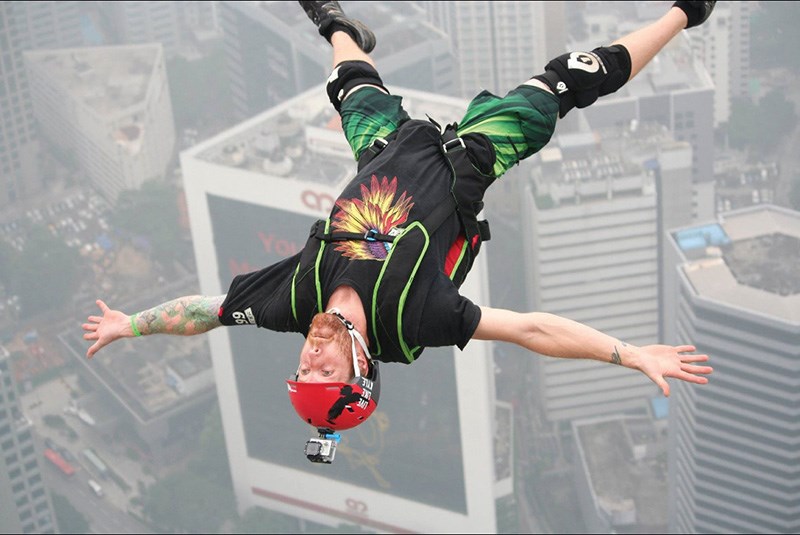For Squamish base jumper Mike Racicot, a jump from the famed KL Tower in Kuala Lumpur, Malaysia has been on his wish list for some time.
While he had backpacked in the country before, he had never made the jump, but in early October he got his wish. He was among the chosen to make 300-metre jumps from the structure over a three-day period.
“This is the first time I went to participate in the event,” he said. “I had a dream of going there.”
Base jumping involves jumping with a parachute or wingsuit from fixed objects, specifically a building,
antenna, span and earth structure such as a cliff. Racicot, known as “Treehouse Mike,” had skydived for years and still does, but he decided to start training for base jumping in 2008, after being inspired by the IMAX documentary, Adrenaline Rush: The Science of Risk, which looks at the world of both activities.
This year’s KL Tower jump attracted approximately 120 men and women from 8 a.m. to 10 p.m. over the three days to make a total of about 3,000 jumps. The tower is the seventh-highest freestanding tower in the world.
Racicot completed 26 jumps during the event but said that some people made as many as 100.
“There was no limit on how much you can jump. It’s just if you’ve got the energy,” he added.
The event added a wrinkle in the form of rope swings off tower cranes for jumpers to use if they wished.
“It would send you pretty good, it would give you another few seconds on your free fall,” he said. “That was a real treat.”
He said he was amazed by one jumper in a wingsuit who made a “most epic” leap off the rope swing.
Racicot bristles a little when people talk about base jumping as an “extreme” sport. While he understands how people can label it as such, he thinks it is a matter of perspective. From where he sits, he considers other activities like some types of climbing to be more extreme.
“I don’t think it’s extreme when you’ve taken the proper route to learn things,” he added.
Racicot worries that people do not understand that base jumping is not something a person simply looking for that adrenaline rush does with little to no training. He started training about seven years ago in Idaho, where he jumped off a bridge after taking a course from an equipment manufacturer.
Training is crucial before anyone ever takes that first leap. At events like the KL Tower jump, participants must meet requirements for experience; they had to have jumped for a minimum of two years and have completed a total of 120 jumps including at least 20 in the past year.
Still, some see base jumping as too dangerous, and the U.S. National Parks Service is one jurisdiction that has taken steps to prevent the activity.
However, Racicot sees more people and places as opening up to the sport, pointing to countries such as Sri Lanka that see it as an opportunity to draw base-jumping tourists.
Racicot also made jumps to the smaller city of Sibu, Malaysia as well as in Thailand as part of the same trip this fall. In all, he racked up 51 jumps over the three-week period.
The renowned jump from the KP Tower was definitely a landmark event for him. More frequently, he makes jumps throughout the year at home in Squamish.
“The Chief is the obvious go-to,” he said, adding that there are other sites in Squamish and throughout the region, like Marble Canyon, that are good places for jumps. “The Sea to Sky corridor has a lot of potential.”




